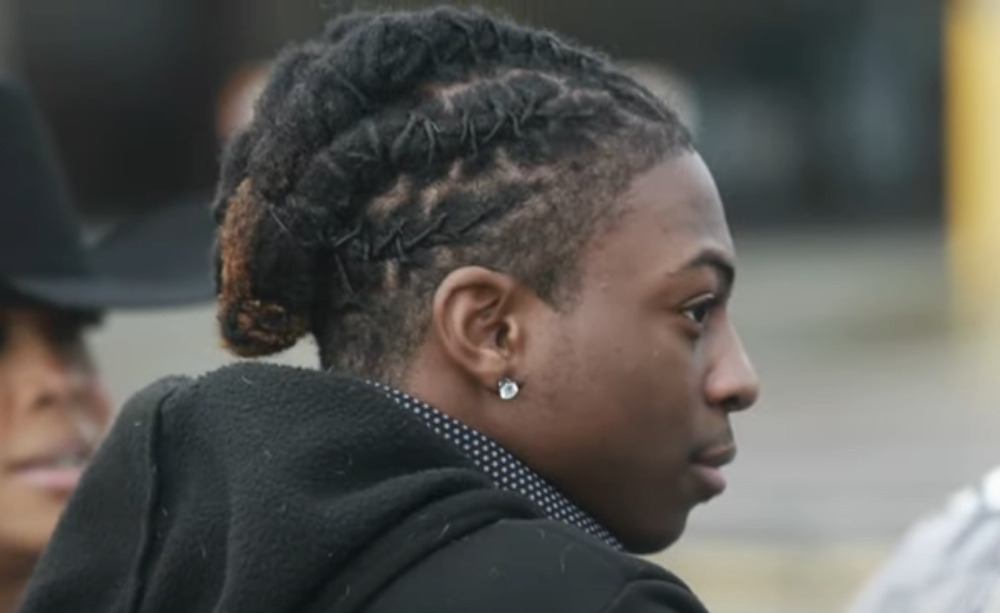
Screenshot/CSC Mornings (Fair Use)
America’s schools don’t always welcome cultural expression: A judge ruled that a Texas school did not violate the CROWN Act by suspending Darryl George for his hairstyle. Barbers Hill ISD removed the Black 18-year-old student from regular classes Aug. 31, 2023, stating he was not complying with the dress code. The Texas CROWN Act, which prohibits race-based hair discrimination, went into effect just one day later.
A Texas judge ruled (video below) on Feb. 22, 2024, that the Barbers Hill School District didn’t violate the law when it punished Darryl George, a Black student, for wearing his hair in long locs. The Texas law in question – the CROWN Act – prohibits discrimination against hairstyles in schools and workplaces. The school district argued – and Judge Chap B. Cain III agreed – that the law doesn’t mention anything about hair length. In the following Q&A, Kenjus Watson, an education professor at American University who researches the psychological and social effects of racism, discusses how the decision upholds a long-standing legacy of cultural assimilation.
What message has the court just sent?
I’d argue it’s a harsh reminder that the natural appearance, cultural expressions and freedom of Black children are incompatible with the objectives and ideals of the school system in the U.S. Those objectives and ideals were created to establish social order, enforce conformity, demand cultural assimilation and suppress marginalized groups.
The court decision in Texas – and the no-long-hair policy in the Barbers Hill Independent School District – might seem outdated, misinformed or at odds with best practices for culturally responsive education. But as I and other researchers have found, strict monitoring and other anti-Black practices – such as those regarding Black children’s hair, bodies, language, clothing and even their presence – are widespread in America’s schools.
What options do Black students have?
Since education is compulsory for minors, the only options for Black families are to find schools that attempt to prioritize their overall well-being by being supportive of their children’s hairstyle and other cultural values, or to educate their children at home, as many Black families do now.
Finding a culturally supportive school can be a challenge. Despite efforts from Black families, educators, leaders and allies to create more inclusive environments in schools, anti-Black racism is pervasive in educational settings – from pre-K through higher education.
Staying in a school system that is hostile to Black cultural expression can threaten children’s well-being. Extensive research has found that racial microaggressions – everyday acts of racism – can adversely affect the mental and physical health of Black people.
My own research has found that it can affect the biological health of Black young people. The hormones the body releases under stressful racial events can damage the DNA of Black students. Over time, this can contribute to higher rates of disease and overall shorter life expectancy among Black people in the U.S. Finding a supportive school can be an even more urgent matter of life and death. Researchers have found that enduring everyday racism in school is also a key factor behind rising suicide rates for Black youth.
What should school leaders consider?
If educational leaders want to see Black students flourish, I believe they should dismantle racist policies that require order, conformity and assimilation. They should replace these with schoolwide microaffirmative practices that validate Black student cultural expressions, identities, resilience and brilliance. They can also prioritize mental and emotional health and wellness.
To move toward a new educational system that truly serves all students, I argue that it is crucial to listen to Black families and students in the development of school policies, curriculum and instruction. Doing so can help place Black families’ current experiences within the broader context of the ongoing struggle against discrimination and unjust legal decisions, such as the one against Darryl George.![]()
***
Kenjus T. Watson, Assistant Professor of Urban Education, American University, teaches courses in the EdD Educational Policy and Leadership Program and collaborates across the School of Education. Watson also works alongside community responsive projects as research lead, educator, and co-founder of the Institute for Regenerative Futures in the College of Education at San Jose State University. His interdisciplinary research has focused on the biopsychosocial impact of everyday anti-blackness and colonization (i.e., racial microaggressions) on Black, Indigenous, and other People of Color, as well as the promise of school abolition, re-Indigenization, and apocalyptic education to bring about healing and wellness for people and the planet.
This article is republished from The Conversation under a Creative Commons license. Read the original article.



























